2023 European Insurance Midyear Investment Outlook: Strong Capital Supports a Broadly Positive View

Vladimir Zdorovenin, PhD
Head of International Insurance Solutions
Strong capital position supports further allocation to return-seeking assets. Despite a turbulent 2022, insurers remain well capitalized and broadly confident about their investments. For many life insurers, solvency ratios are expected to improve further, as higher investment returns continue to generate capital and drive customer inflows into more attractive life products.
Liquidity remains adequate despite higher lapse rates for some insurers. Despite concerns about the lapse risk in certain markets, strong solvency and liquidity buffers for most life insurers suggest that they are well positioned to pursue opportunities in illiquid credit and real assets. These investments could help reduce balance sheet sensitivity to market shocks and provide some protection against prolonged inflation.
Broader diversification and active management can help build more resilient bond portfolios. While the credit quality of insurers’ bond portfolios has remained very high quality, the risk of defaults and downgrades is increasing. This credit environment calls for a more active approach to portfolio management and greater geographic diversification of insurers’ corporate credit portfolios – and aligns with our latest fixed income investment outlook.
Banking industry woes create opportunities in private credit. In our view, the turmoil in the banking sector does not pose an immediate and direct threat to insurers’ investment performance. A retrenchment in bank lending could create new opportunities for insurers to invest in high-quality private debt.
Pockets of opportunity in European real estate. Insurers’ real estate portfolios have experienced declines in line with the market. While a broad recovery is not yet in sight, we see opportunities in segments where inherent supply constraints may still create favorable supply-demand dynamics. Pursuing these opportunities could require complementing in-house investment capabilities with those of specialist real estate investment managers.
Higher business volumes in the UK pension risk transfer market make insurers look for opportunities globally. Growing volumes in the pension risk transfer market, as well as reform of risk margin and matching adjustment mechanisms under the emerging “Solvency UK” regime, are causing British life insurers to increasingly look to international markets. In the UK, regulatory concerns about the risks inherent in funded reinsurance strengthen the case for pursuing global opportunities in illiquid credit through partnerships with external asset managers that offer structuring know-how, proven origination capabilities, and regulatory expertise.

At the midyear point, European insurers remain broadly confident in their investment portfolios. Given insurers’ strong capital position, on the one hand, and the persistent macroeconomic and geopolitical uncertainty, on the other, we see potential for expansion into a more global and diverse opportunity set.
Despite a turbulent 2022, most European insurers remain well capitalized, with the median European Economic Area (EEA) group solvency ratio standing at 225% as of fourth-quarter 2022, with year-end results well within the target range for most listed life insurers. UK insurers have enjoyed an even stronger improvement in capital, driven by the sharp rise in sterling rates over the course of 2022, with the median solvency ratio rising from 180% to 202% for life insurers and from 198% to 204% for general insurers.1
Industry risk levels remain broadly unchanged from a year ago. In EIOPA’s latest risk dashboard, most indicators continue flashing yellow,2 with a negative outlook for credit, market, and underwriting risks.3 Insurance CEOs are more optimistic than regulators. In their first-quarter 2023 trading updates, most listed life insurers reported stable solvency ratios and conveyed a confident outlook for their investments. Analysts expect life insurers’ solvency to improve further, as higher investment returns continue to generate capital and drive customer inflows into more attractive life products.
At the same time, persistent inflation, economic slowdown, geopolitical tensions, and the enduring risks of recession and tightening credit make insurers rethink their asset and capital allocation decisions. While there’s plenty of menacing clouds on the horizon, we also see this as a time of opportunity. Pursuing these opportunities across the full spectrum of asset classes and geographies would require an active approach to asset allocation and portfolio construction, disciplined risk management, and close partnership between in-house investment teams and delegated asset managers.
Liability risks: lapses and liquidity
Growing regulatory scrutiny4 and the much-discussed demise of the Italian life insurer Eurovita5 have put the spotlight on insurers’ asset liquidity and policy lapse risk. In our view, insurers’ liquidity and capital buffers are more than adequate to cover the risk of increased surrenders – and to support further allocations to return-seeking illiquid assets.
Life insurance lapses have remained stable for most insurers in 2022, with a median rate of 3.0%.6 The wide variation in product mix – and thus lapse risk profiles – across the EU and between individual insurers means that averages can be misleading, with French and Italian insurers among the more exposed to lapse risk. For insurers most exposed to lapse risk (those at the 90th percentile of the distribution), the lapse rate has climbed from 6.5% at year-end 2021 to 6.9% at year-end 2022.
While this is an unwelcome development, the industry is well-positioned to withstand these – and much higher – lapse rates: most life insurers’ liquid asset ratios are in the 35% to 55% range (with a median of 45.6%), comfortably above the conceivable range for stressed policy surrenders. Efficiently accessing this liquidity in a forced sale scenario would require close collaboration between in-house risk, investment, and actuarial teams and third-party asset managers tasked with managing insurers’ bond portfolios.
While we do not rule out the possibility that policy surrenders will dent the profitability of individual insurers in 2023 and beyond, the likelihood of mass lapses eroding capital and creditworthiness on an industrywide scale seems extremely remote.7 Given their strong liquidity position and elevated bond market volatility, insurers appear well positioned to pursue opportunities in illiquid credit and real assets. Higher allocations to private assets could help reduce balance sheet sensitivity to market shocks and provide a degree of protection against persistent inflation.
Investment risks and opportunities
Corporate bonds: geopolitical and downgrade risks call for global diversification
Rising delinquencies, bank failures, and growing corporate default and downgrade rates are all making insurers rethink the credit risk in their portfolios. While a typical insurer’s corporate bond portfolio is of very high credit quality, it is also often geographically concentrated, with significant overweight in the insurer’s home country. Given the elevated macroeconomic and geopolitical uncertainty, insurers could benefit from a more global approach to fixed income portfolio construction, with broader diversification and active management helping pursue opportunities across the full spectrum of corporate credit without compromising on quality and resilience.
Sector and Rating Composition of EEA Insurers’ Corporate Bond Holdings
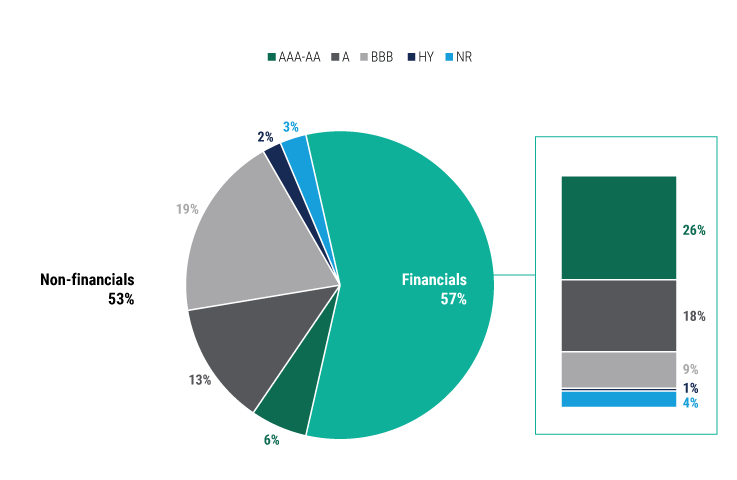
Source: EIOPA Financial Stability Report June 2023; PineBridge Investments analysis and interpretation.
As of fourth-quarter 2022, the median credit quality step (CQS) of EEA insurers’ corporate debt investments stood at CQS 2, equivalent to an S&P rating of AA, with a negligible 2.6% exposure to high yield debt.5 In their first-quarter trading updates, listed life insurers reported broadly stable credit quality in their bond portfolios year-to-date, with no defaults and rating upgrades outpacing downgrades.8
This is no reason to be complacent. Corporate downgrades and defaults are expected to rise in 2023-2024, albeit from historically low levels. In the past, there have been sharp increases in downgrades during and after recessions. While Moody’s “fallen angel” rate for BBB rated corporates was as low as 1.1% in 2022 (2.3% including Russian issuers), it reached 7.9% in 2016 and was as high as 11.9% in 2002, after the dotcom bubble burst.9 Downgrades would expose insurers to the double whammy of mark-to-market losses and significantly higher Solvency II capital requirements on instruments downgraded to high yield. The risk is particularly material for UK life insurers given the "BBB cliff edge” effect in their matching adjustment portfolios.10
Global Corporate ‘Fallen Angel’ Rate
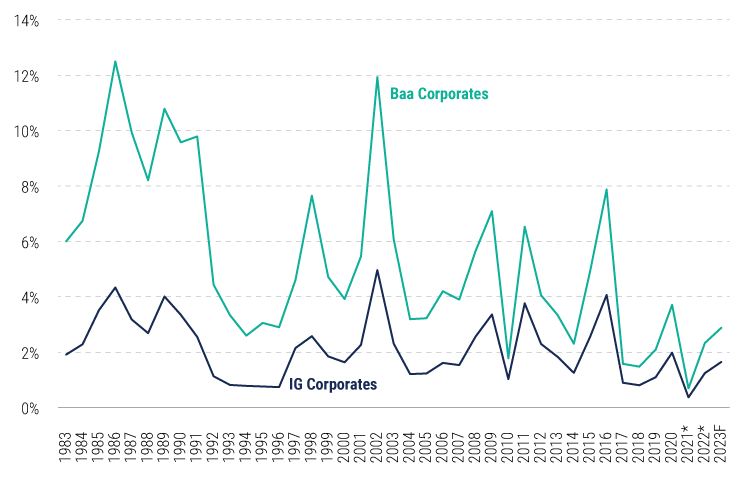
Source: Moody’s (13 March 2023) Annual default study: Corporate default rate will rise in 2023 and peak in early 2024, PineBridge Investments interpretation. *Excluding Russian issuers; F – Moody’s forecast.
The growing credit risk necessitates a more active approach to portfolio management supported by thorough credit research. Many insurers are increasingly relying on in-house teams to manage their fixed income investments. However, partnering with a specialist asset manager could expand the opportunity set and help build more efficient asset allocations without compromising on credit quality. For insurers with an appetite for credit risk, selective exposure to high-yield debt within the pre-allocated capital budget can further enhance the efficiency of Solvency II capital.
Home Bias in EEA Insurers’ Corporate Bond Investments (Key Markets)
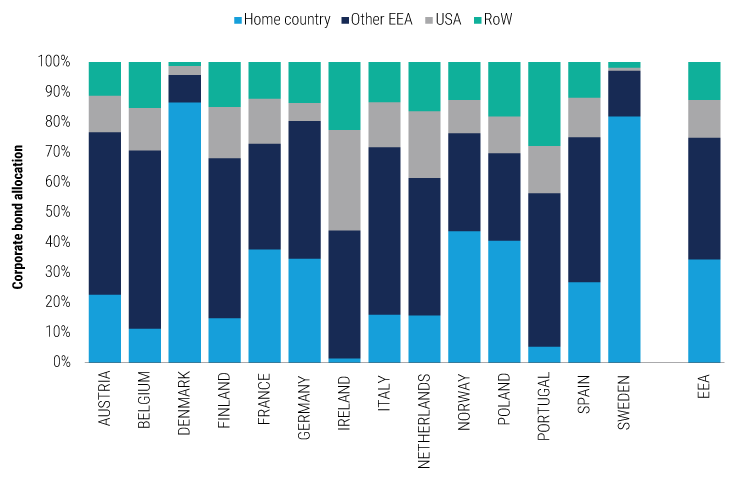
Source: EIOPA Insurance Statistics - Exposure data – Solo Quarterly, 2022 Q4; PineBridge Investments analysis and interpretation. Calculated as the ratio of corporate bond exposure by location of investment to total value of corporate bond exposures. Rest of the World (RoW) includes Australia, Canada, Switzerland, the UK, and others.
Many insurers have a strong home bias in their corporate bond investments. On average, life insurers in France and Germany invest more in their home-country corporate debt than in all non-EEA corporates combined. In aggregate, EEA insurers allocate three-quarters of their corporate bond investments to the EEA. A further 12% is allocated to the US; emerging markets account for under 2%.11 This puts insurers at risk of missing opportunities in the $7.8 trillion US corporate and $0.8 trillion Asian dollar corporate bond markets.12 A more global approach to fixed income portfolio construction could reduce concentration and improve diversification across issuers, sectors, and geographies. Uncovering the new opportunities may require teaming up with a fixed income manager with an established presence in these less-familiar markets.
While insurers can now enjoy higher yields on their high-quality domestic bond portfolios, elevated credit and geopolitical risks call for active portfolio management and global diversification. Implementing a global fixed income asset allocation may require complementing in-house capabilities with those of external managers. These partnerships would set a high bar for the managers, given the need to incorporate insurance-specific objectives and constraints, such as liability-aware duration targets, risk-based capital efficiency considerations, and cost of downgrade analysis into mandate design and portfolio management.
Illiquid credit: banking sector turmoil presents more opportunities than threats
Rising delinquencies, deposit outflows, and the daunting prospect of additional capital and liquidity curbs in the wake of the recent US bank runs and the fire sale of Credit Suisse are likely to weigh on banking industry profitability and creditworthiness in 2023 and beyond. In our view, this does not pose a direct threat to insurers’ investments. EEA insurers’ median exposure to banks – across deposits and investments in bank debt and equity – was 13.5% of total assets as of fourth-quarter 2022 (versus 13.0% in fourth-quarter 2021).13 Insurers’ exposures are mostly to domestic and European banks, with the total exposure to US regional banks estimated at about €1.2 billion across 39 insurance groups, or 0.02% of the industry’s total investments. During the recent emergency takeover of Credit Suisse, European insurers have also been keen to highlight the immateriality of their exposures to bank subordinated debt.
A retrenchment in bank lending could create new opportunities for insurers to invest in private debt.14 To capture the full range of opportunities in this broad and fragmented universe, insurers may seek to complement their in-house origination capabilities with those of third-party asset managers. Given the growing scrutiny of loans originated at the peak of the market,15 insurers are well advised to partner with experienced managers that focus on prudent underwriting, portfolio diversification, and durability to weather challenges.
Real estate: headline risks, niche opportunities
European real estate markets have had a rough year, with property values falling by 16% in the UK and by 11%-12% in Germany and France over the course of 202216 and continuing to trend down. The pain has been even more acute for listed real estate, with the benchmark FTSE EPRA NAREIT Developed Europe Index falling 36.5%, wiping out virtually all its gains since 2016. The repricing is likely to continue in 2023. Based on risk sensitivities reported in large life insurers’ 2022 Solvency and Financial Condition Reports, a further 15% decline in property values could reduce their SCR coverage ratios by up to 10 to 20 percentage points.
The value of EEA life insurers’ real estate equity and debt exposures declined by almost 11% year-on-year, broadly in line with the property market. In relative terms, real estate has been a more resilient investment than fixed income, with the value of insurers’ government and corporate bond holdings falling by 27% and 21% respectively over the same period. As a result, real estate exposures accounted for 10.3% of EEA insurers’ general account investments as of the end of 2022, the highest year-end level since at least 2017.17
Home Bias in EEA Insurers’ Real Estate Investments (Key Markets)
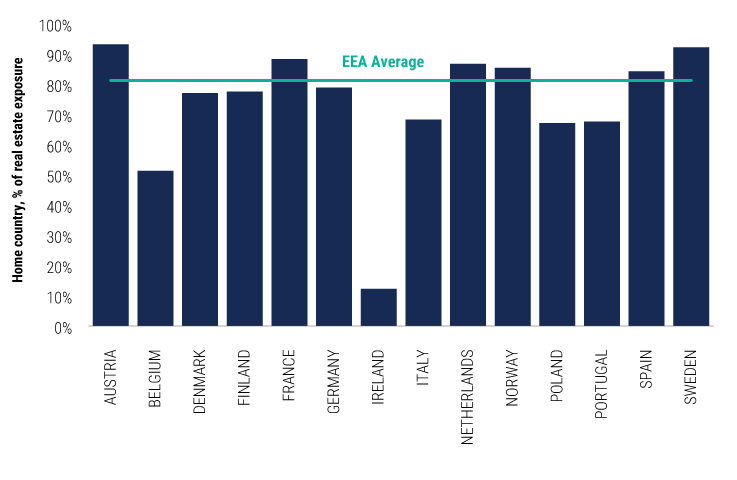
Source: EIOPA Insurance Statistics - Exposure data – Solo Quarterly, 2022 Q4; PineBridge Investments analysis and interpretation. The percentage of home-country real estate exposure is calculated as the ratio of the value of insurers’ real estate exposures (own use, indirect, and general) in their home country to the total value of real estate exposures for which location is reported. For Belgium and the Netherlands, over 50% of insurers’ real estate exposure location is not reported, potentially leading to misestimation of the home bias for these markets.
Insurers’ real estate investments show a strong home bias. On average, over 80% of a European insurer's real estate exposure (and nearly all direct exposure to real estate equity) is in the home country. While comparable figures are not available for the UK, individual life insurers’ disclosures suggest an even higher concentration in the UK real estate market.
Concentrated, illiquid exposures exacerbate tail risk and can lead to contagion. These risks can be mitigated by broader diversification across geographies and investment styles – for example, by complementing the income-oriented home-country portfolio with an allocation to a pan-European opportunistic strategy. While we do not expect a broad and uniform recovery in European real estate markets in the near term, there remain segments where overall economic growth is less of a factor and where inherent supply constraints can still create favorable supply-demand dynamics. These include opportunities in rental housing, green prime central city offices, and last-mile logistics. Uncovering these niche opportunities and structuring resilient deals against the backdrop of a marketwide repricing may require partnering with an experienced real estate investment manager.
Regulatory developments
The birth of Solvency UK
The publication of HM Treasury Draft Insurance and Reinsurance Undertakings Regulations on 22 June 2023 and the subsequent PRA consultation on 29 June 2023 mark the formal birth of Solvency UK, a national regulatory regime that will bear material differences from its continental European ancestor. With some of the changes due to take effect as early as this year, we expect a sizable positive impact on UK life insurers’ solvency and their ability to write new business and deploy capital to support investment in the real economy.
Timeline of Solvency UK Reforms
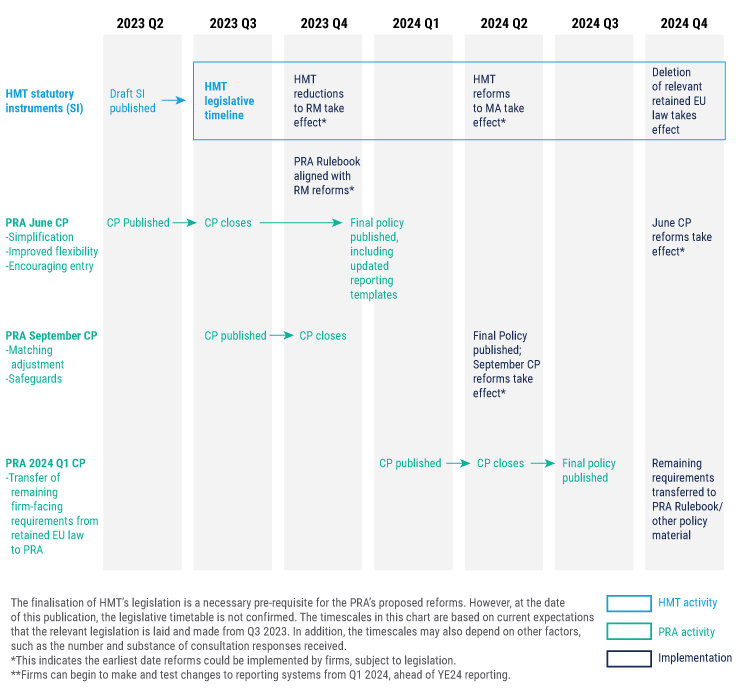
Source: Bank of England Prudential Regulation Authority, 29 June 2023
The main changes in the Draft Regulations are:
Reduction in risk margin (no later than December 2023) driven by a reduction in cost of capital from 6% to 4%, which is expected to have a material positive impact for life insurers. In addition, life insurers will benefit from the introduction of a risk tapering factor that will reduce the risk margin on long-dated liabilities.
Changes to matching adjustment regulations (no later than June 2024) to allow for a limited proportion of assets with cash flows that are not fully fixed in time and size.
Solvency regulation migration into the PRA Rulebook (no later than December 2024) will be accomplished by removing regulations from the UK statute book and reenacting them in the PRA Rulebook. This should give the PRA further flexibility in modifying insurance regulations, such as the matching adjustment and fundamental spread mechanism.
The June 2023 PRA consultation focuses on simplifying insurance reporting, streamlining review and approval of internal models, adding more flexibility in calculation of group capital adequacy, and simplifying entry into the UK insurance market. The PRA aims to publish the final policy on these aspects of the regulation toward the end of 2023.
Changes to the matching adjustment mechanism will be addressed in a separate consultation scheduled for September 2023. The PRA’s industry consultations on matching adjustment (MA) have focused on enhancing the fundamental spread mechanism to account for the additional risk of assets’ highly predictable cash flows, developing a more granular fundamental spread notching, and developing a senior management attestation and disclosure regime for the fundamental spread and matching adjustment calculations.
The enactment of these changes should broaden the universe of MA-eligible assets to include those with highly predictable but not fully fixed cash flows – potentially helping UK life insurers to tap into the deep and relatively underserved pool of illiquid US commercial real estate debt – and better align the derivation of the matching adjustment benefit with the credit risk of the constituent investments.
Spotlight on pension risk transfer
With an expected transaction volume of more than £500 billion over the next decade in the UK18 and potential new flows driven by the pension reform in the Netherlands,19 the pension risk transfer (PRT) market continues to be the focus of regulatory attention. The PRA has identified the risks associated with PRT transactions and the emergence of funded reinsurance as its supervisory priorities for 2023,20 and highlighted the risks of funded reinsurance arrangements in a recent industry feedback letter.
The rapid growth of the PRT market and a finite pool of domestic MA-eligible assets are driving UK insurers toward greater reliance on funded reinsurance as a central building block in bulk purchase annuity (BPA) transactions. In a funded reinsurance transaction, a life insurer would transfer both asset and longevity risk to a reinsurer. Many of the reinsurers are new market entrants or traditional players that have undergone a significant transformation of their business model. In the PRA’s view, this creates a risk of underestimating the counterparty risk in these transactions, due to the limited relevance of historical experience in risk quantification, sub-optimal collateral portfolios, and the increasingly concentrated and correlated business models of credit-focused reinsurers.21
Funded reinsurance helps UK life insurers to bid more competitively in BPA transactions by leveraging the capabilities of their reinsurance partners in originating assets outside the insurers’ core investment expertise, including illiquid and private assets, non-core liquid assets, and non-sterling assets. This comes at the cost of additional risks and uncertainties around asset valuations, probability of recapture, and asset-liability mismatches.
Final specification of the Insurance Capital Standard for internationally active insurance groups
On 23 June 2023, the International Association of Insurance Supervisors (IAIS) launched the final consultation in preparation of adoption of the Insurance Capital Standard (ICS) as the prescribed capital requirement (PCR) for internationally active insurance groups (IAIG), scheduled for December 2024.
Most importantly, provisions have been made for allowing the use of internal models for calculating capital requirements under ICS as a PCR, with specific requirements for the model approval process, ongoing monitoring, documentation, and eligibility.
The consultation also includes important changes to market risk capital requirements. Stresses for non-default spread risk have been revised, with absolute stresses of ±50 bps to ±100 bps (depending on credit rating) replaced with relative stresses of ±75%. In addition, a differentiated treatment has been introduced for investments in qualifying infrastructure debt and equity, bringing the ICS equity capital charges in closer alignment with those under Solvency II.
Finally, changes have also been introduced to the market-adjusted valuation of liabilities and the admissibility criteria for liability-backing assets for the so-called “middle bucket” liabilities. In our evaluation, the proposed changes will incentivize closer matching between insurance liabilities and investment assets, putting a higher proportion of an IAIG’s assets in scope of a matching adjustment-like mechanism that will look all too familiar for large UK life insurers.
The IAIS also plans to assess whether the aggregation method (AM) for calculating group capital adequacy, which is being independently developed in the US, can be considered as an equivalent to the ICS as prescribed capital requirement. The outcome of this review will determine the future of the ICS in the US and, to some extent, its cachet as a global risk-based capital standard.
The adoption of ICS as a prescribed capital requirement will add another layer of complexity for global insurers that already balance the competing and overlapping requirements of multiple regulatory regimes at the group and local entity level, with considerations of economic capital efficiency and rating capital adequacy. Navigating the ever-expanding regulatory maze could be made easier by partnering with a fixed income asset manager with global capabilities and hands-on knowledge of the new and emerging risk-based capital regimes.22
Footnotes
1 Bank of England Statistics: Insurance aggregate data quarterly report (accessed 13 June 2023)
2 Or orange for Macro, Market, and Digitalization & Cyber risks (unchanged since July 2022)
3 EIOPA (15 May 2023) May 2023 Risk Dashboard (Q4-2022 Solvency II Data)
4 E.g., see Bank of England Prudential Regulation Authority (23 January 2023) Insurance Stress Test 2022 feedback; Bermuda Monetary Authority (24 February 2023) Consultation Paper: Proposed Enhancements to the Regulatory Regime and Fees for Commercial Insurers; Insurance Asset Risk (15 June 2023) Liquidity risk remains one of less understood risks in market, according to IAIS; Bank of England (16 June 2023) The building blocks of resilience - speech by Sarah Breeden
5 E.g., see Reuters (7 February 2023) Italian insurer regulator halts redemptions at Cinven-owned Eurovita
6 EIOPA (22 June 2023) Financial Stability Report June 2023
7 E.g., see Fitch (3 April 2023) What Investors Want to Know: Lapse Risk in French Life Insurance; Fitch (17 April 2023) Italian Life Insurers Face Profit Dent from Higher Surrenders
8 E.g., see Aviva Plc (24 May 2023) Shareholder Asset Portfolio Update; L&G (15 March 2023) 2022 Annual Report and Results
9 Exhibit 17 in Moody’s (13 March 2023) Annual default study: Corporate default rate will rise in 2023 and peak in early 2024
10 E.g., see HM Treasury (April 2022) Review of Solvency II: Consultation
11 EIOPA (22 June 2023) Financial Stability Report June 2023, PineBridge Investments interpretation and analysis
12 Market value of ICE BofA US Corporate Index (C0A0) and ICE BofA Asian Dollar Index (ADOL) as of 31 May 2023
13 2022 Q4 EIOPA Insurance Statistics – Asset Exposures – Solo – Quarterly (accessed 13 June 2023)
14 E.g., see Mercer (1 June 2023) Four reasons to consider private debt - Private market insights
15 E.g., see Financial Times (26 June 2023) Moody’s warns of ‘serious challenge’ to $1.4tn private credit market; Moody’s (22 June 2023) Moody's affirms Ares Capital's Baa3 senior unsecured rating; outlook stable; Moody’s (22 June 2023) Moody's affirms Owl Rock Capital Corporation's Baa3 senior unsecured rating; outlook stable
16 MSCI UK Quarterly Property Index, MSCI Europe Quarterly Property Index, 2023 Q1 change from previous year
17 PineBridge Investments estimate of year-on-year change in life insurers’ general account real estate exposure in EIOPA Insurance Statistics – Asset Exposures – Solo – Quarterly. The change is the combined impact of mark-to-market on existing holdings, new investments, and divestments.
18 E.g., see Lane Clark & Peacock (21 March 2023) 2022 another strong year for UK pension risk transfer as the market gears up for a sharp acceleration over 2023-2025
19 E.g., see Fitch Ratings (17 March 2023) L&G, Lifetri Deal Underscores Growth of Dutch Pension Risk Transfer Market; JPMorgan Europe Equity Research (23 June 2023) Dutch Pension Reform and implications for insurers
20 Bank of England Prudential Regulation Authority (10 January 2023) Insurance supervision: 2023 priorities
21 Bank of England Prudential Regulation Authority (15 June 2023) Feedback on the PRA’s preliminary thematic review work on funded reinsurance arrangements
22 For more on capital-efficient investing under ICS, see e.g. PineBridge Investments (22 May 2023) The Case for Collateralized Loan Obligations for Global Insurers; PineBridge Investments (20 March 2023) How Insurers Can Benefit from Capital-Efficient Emerging Market Debt Investing
Disclosure
Investing involves risk, including possible loss of principal. The information presented herein is for illustrative purposes only and should not be considered reflective of any particular security, strategy, or investment product. It represents a general assessment of the markets at a specific time and is not a guarantee of future performance results or market movement. This material does not constitute investment, financial, legal, tax, or other advice; investment research or a product of any research department; an offer to sell, or the solicitation of an offer to purchase any security or interest in a fund; or a recommendation for any investment product or strategy. PineBridge Investments is not soliciting or recommending any action based on information in this document. Any opinions, projections, or forward-looking statements expressed herein are solely those of the author, may differ from the views or opinions expressed by other areas of PineBridge Investments, and are only for general informational purposes as of the date indicated. Views may be based on third-party data that has not been independently verified. PineBridge Investments does not approve of or endorse any republication of this material. You are solely responsible for deciding whether any investment product or strategy is appropriate for you based upon your investment goals, financial situation and tolerance for risk.



